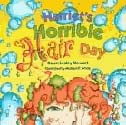Tips for Writing a Successful Picture Book
by Dawn Lesley Stewart
Do not let the apparent simplicity of a picture book fool you into
thinking it is easy to write one. Picture books for children are a balance
of text and illustration that in combination create the whole story.
Write concisely, and let the artwork act as the adjectives and adverbs.
Here are some ideas of how to make your words appeal to both editors and
children.
TYPES OF PICTURE
BOOKS
Consider whether
the book is prose, rhyme, concept book or a specialty book. A combination
of book styles might work for your manuscript. For instance, Harriet's
Horrible Hair Day combines prose within the concept of a counting
book. Consider these types of books when plotting: alphabet book, concept
book (ex: shapes, textures), counting book, novelty book (ex: pop-up book,
lift-the-flap book), poetry, prose.
POETRY vs. PROSE
As a rule, it is
easier to sell prose than it is to market a poetry book. If writing in
rhyme (or poetic form), make sure the poetry is exceptional. The average
length of a picture book is 32 pages. Write no more than 1,500 words for a
picture book manuscript, with fewer than 100 words on any one page.
And consider that some editors think manuscripts that are over 500 words are too long. Remember, the more words used, the less room for artwork.
KEEP THE STORY
FLOWING
Characters in a
picture book story are not described in detail. The illustrator conveys
description via art. For instance, in Harriet's Horrible Hair Day,
nowhere is the color of Harriet's hair mentioned, nor are any of the
characters described. Also notice that the story flows so the scenery in
each illustration is different, maintaining viewer interest. The story
moves from the outside yard into the house. Events within the story bring
each illustration to life with a variety of action. Remember, the artist
needs a diversity of either scenery or action (or both) to create lively
illustrations.
ALLITERATION
Use alliteration in
the title (Harriet's Horrible Hair Day) or in the text.
Alliteration creates a humorous cadence. It's attention-getting as well as
an excellent method of exploring sounds.
3 WORDS OR 3 PHRASES
Repeat three words
or phrases in the story to add rhythm and word play. A classic example of
this is from The Three Little Pigs: "I'll huff, and I'll puff,
and I'll blow your house down." Notice that children will soon repeat
the words or phrases, anticipating when the next repeated line will occur.
TRANSITION
Encourage the
reader to turn pages. One page-turning enticement is to use ellipsis (three dots . . .). Partially write a sentence, use the dots, and
finish the sentence on the following page. Combine the ellipsis with
transition words such as and . . . then . . . but. Another
flip-the-page enticement is the cliffhanger, which adds suspense. End the
page with something that has the reader asking, "What happens next?" Yet another
page-turning lure is to pose a question at the end of the page. To find the answer, the
reader must continue reading the book.
There are many writing techniques available to help capture reader
attention. You may not want to use all of these in the same story (use
sparingly for greater effect), but a few of these techniques will add fun
to the tale and make the story flow. Invite the reader into your story and
keep him there.
Copyright 2000 Dawn Lesley Stewart
Printer Friendly pdf of article
All rights reserved. You may print this article for personal use. No part of this work may be copied, distributed or used in any way without written permission from the author.
|






